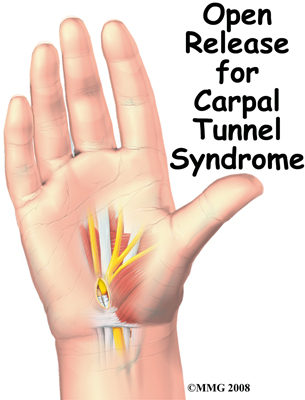What should I expect after surgery?
Once the stitches are removed, many surgeons prefer to have their patients attend occupational or physiotherapy sessions, such as those offered at Plainsview Physiotherapy. After this procedure, our patients are usually treated two to three times each week for four to six weeks, although the time required for recovery does vary. As mentioned, however, it may take several months for the incision pain to go away and for maximum hand strength to return.
At first, our physiotherapist will attempt to reduce pain and swelling. We may apply hot or cold packs, electrical stimulation, and ultrasound. Massage strokes directed from the fingers toward the elbow help move swelling away from the hand and wrist.
Our physiotherapist will use hands-on stretching and active hand and wrist exercises to encourage range of motion. We'll show you how to carefully strengthen your hand by squeezing and stretching special putty. Our therapist may also provide you with home exercises to improve hand and finger movement and strength.
Some of our physiotherapy treatments are used to reduce sensitivity in the incision. The methods are applied gently at first. One method is for our physiotherapist to massage the incision for several minutes. We will teach you this massage technique so that you can do it on your own five to six times each day. Another way to desensitize the incision is to grip materials of various textures or to rub them over the incision. These treatments are gradually done with more vigor as the sensitivity of the incision eases.
Another of our therapy goals is to prevent scar tissue formation. Our physiotherapist will use scar massage to reduce scar tissue formation in the incision and in the nearby skin and soft tissues. To prevent scar tissue from forming between the flexor tendons and median nerve, we also instruct patients in a series of fist positions. These specialized exercises encourage the normal gliding action of the structures within the carpal tunnel.
As you progress, your Plainsview Physiotherapy physiotherapist will also give you exercises to help strengthen and stabilize the muscles and joints in your hand. We will use other exercises to improve fine motor control and dexterity. Some of the exercises that we'll teach you are designed to get your hand working in ways that are similar to your work tasks and sport activities.
Our physiotherapist will help you find ways to do your tasks that don't put too much stress on your hand and wrist. Before your therapy sessions end, we will teach you a number of ways to avoid future problems.
At Plainsview Physiotherapy, our goal is to help speed your recovery so that you can more quickly return to your everyday activities. When your recovery is well under way, regular visits to our office will end. Although we will continue to be a resource, you will be in charge of doing your exercises as part of an ongoing home program.
Plainsview Physiotherapy provides physiotherapy services in Burlington.
Portions of this document copyright MMG, LLC.











